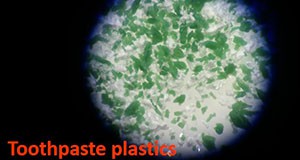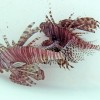
Plastic, plastic everywhere! We live in a world where we are surrounded by plastic: from packaging materials and cutlery to plastic appliances and medical devices. Since the mid-twentieth century, plastic has been a boon to humanity and an integral part of our modern lives. However, plastic debris is a major concern due to its abundance and persistence in the environment. Plastic contaminants not only include plastic debris characterized by large size but also small pieces of plastic in the millimeter size range; these inconspicuous “microplastics” have become a major concern because of their widespread presence in different environments and diverse organisms. This six-page fact sheet discusses the sources of microplastics, their effects on the environment, and ways to minimize microplastics pollution and exposure. Written by Yun-Ya Yang, Ignacio A. Rodriquez, Maia McGuire, and Gurpal S. Toor, and published by the Soil and Water Science Department.
http://edis.ifas.ufl.edu/ss649
Tag: Maia McGuire
Third Grade Manatee Curriculum

This 19 fact sheet curriculum series provides a series of individual lessons covering manatee biology and ecology, as well as highlighting some of the ways that humans impact and can protect manatees. The curriculum has been written at a third grade level but can be adapted for older or younger students. (Photo credit: Keith Ramos, USFWS)
http://edis.ifas.ufl.edu/topic_series_third_grade_manatee_workbook
Ecosystem Services Valuation for Estuarine and Coastal Restoration in Florida
 Throughout Florida’s history, humans have altered the coastlines, leading to large-scale degradation of coastal ecosystems. This has led to the loss of associated ecosystem services, including products such as food and timber and processes like coastal protection and disease control. Unfortunately, ecosystem restoration efforts have not always been a priority for coastal management. This 10-page literature review surveys the available ecosystem-service valuation literature for five of Florida’s coastal natural communities–oyster reefs, beach dunes, mangrove forests, seagrass beds, and salt marshes–to facilitate the quantification of ecosystem services to provide a better measure of the full impact of restoration efforts. Written by Susanna Blair, Carrie Adams, Tom Ankersen, Maia McGuire, and David Kaplan, and published by the UF Department of Sea Grant, November 2014. (UF/IFAS photo by Tyler Jones)
Throughout Florida’s history, humans have altered the coastlines, leading to large-scale degradation of coastal ecosystems. This has led to the loss of associated ecosystem services, including products such as food and timber and processes like coastal protection and disease control. Unfortunately, ecosystem restoration efforts have not always been a priority for coastal management. This 10-page literature review surveys the available ecosystem-service valuation literature for five of Florida’s coastal natural communities–oyster reefs, beach dunes, mangrove forests, seagrass beds, and salt marshes–to facilitate the quantification of ecosystem services to provide a better measure of the full impact of restoration efforts. Written by Susanna Blair, Carrie Adams, Tom Ankersen, Maia McGuire, and David Kaplan, and published by the UF Department of Sea Grant, November 2014. (UF/IFAS photo by Tyler Jones)
http://edis.ifas.ufl.edu/sg134
Invasive Species of Florida’s Coastal Waters: The Red Lionfish (Pterois volitans) and Devil Firefish (P. miles)
 Two species of Indo-Pacific lionfish (Pterois volitans and P. miles) are the first reported non-native marine fish to become established in the Atlantic Ocean. Genetic studies indicate that lionfish in the Atlantic are likely all descendants of a few individuals, consistent with the widely held belief that lionfish were introduced into the Atlantic as a result of accidental or deliberate release of aquarium pets. Regardless of the method of introduction, the prolific spread of these invasive species in the Atlantic Ocean ecosystem is cause for concern. This 5-page fact sheet was written by Maia McGuire and Jeffrey HIll, and published by the UF Department of Sea Grant, January 2013.
Two species of Indo-Pacific lionfish (Pterois volitans and P. miles) are the first reported non-native marine fish to become established in the Atlantic Ocean. Genetic studies indicate that lionfish in the Atlantic are likely all descendants of a few individuals, consistent with the widely held belief that lionfish were introduced into the Atlantic as a result of accidental or deliberate release of aquarium pets. Regardless of the method of introduction, the prolific spread of these invasive species in the Atlantic Ocean ecosystem is cause for concern. This 5-page fact sheet was written by Maia McGuire and Jeffrey HIll, and published by the UF Department of Sea Grant, January 2013.
http://edis.ifas.ufl.edu/sg132
Laws that Protect Florida’s Wildlife (WEC48/UW076)
 Endangered species are not the only wildlife protected by the legal system. All of Florida’s wildlife is more or less safeguarded by a variety of laws. Laws addressing wildlife can be found at the federal, state, regional, and local levels of government. Wildlife protection may also take the form of conventions, treaties, and executive orders. All are subject to periodic change. For example, legislators can alter or delete laws every year. This 5-page fact sheet summarizes federal laws and state statutes and rules. Written by Joe Schaefer, John Tucker, and Maia McGuire, and published by the UF Department of Wildlife Ecology and Conservation, February 2012.
Endangered species are not the only wildlife protected by the legal system. All of Florida’s wildlife is more or less safeguarded by a variety of laws. Laws addressing wildlife can be found at the federal, state, regional, and local levels of government. Wildlife protection may also take the form of conventions, treaties, and executive orders. All are subject to periodic change. For example, legislators can alter or delete laws every year. This 5-page fact sheet summarizes federal laws and state statutes and rules. Written by Joe Schaefer, John Tucker, and Maia McGuire, and published by the UF Department of Wildlife Ecology and Conservation, February 2012.
http://edis.ifas.ufl.edu/uw076
SGEF175/SG094 Invasive Species of Florida’s Coastal Waters: The Asian Green Mussel (Perna viridis)
SGEF-175, a 5-page illustrated fact sheet by Maia McGuire and John Stevely, describes this non-native marine animal that has been found in numerous locations in Florida, Georgia and South Carolina — distribution, biology, habitat, impacts, and what people can do. Published by the Florida Sea Grant Program, August 2009.
http://edis.ifas.ufl.edu/SG094
WEC48/UW076 Laws that Protect Florida’s Wildlife
Revised! WEC-48, a 6-page fact sheet by Joe Schaefer, John Tucker, and Maia McGuire, summarizes laws and regulations at the Federal and State level that protect Florida’s wildlife, and how to report violations or wildlife emergencies. Published by the UF Department of Wildife Ecology and Conservation, October 2008.
http://edis.ifas.ufl.edu/UW076